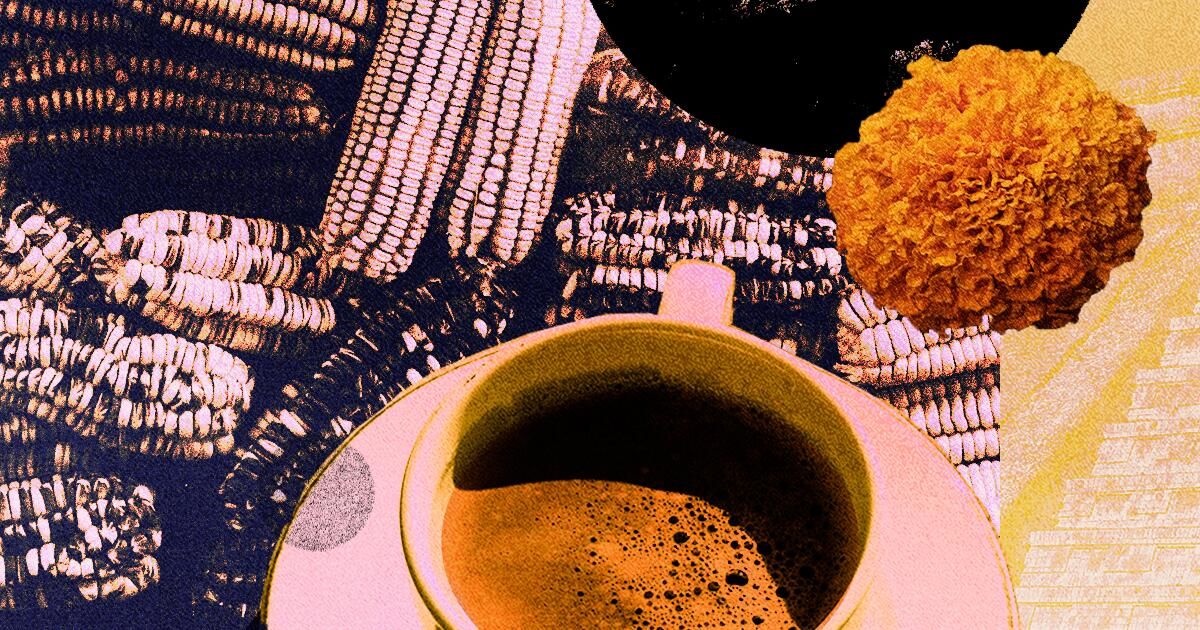To warm up on cold mornings or at the dawn of life, to obtain energy and vitality, there is atole.
Atole is a hot drink originating from pre-Hispanic Mesoamerica flavored with fruits, commonly thickened with masa or pinole and sweetened with honey. Today, the types of flavors that exist within atole, both sweet and savory, are long and regional, spanning from North to Central and South America.
Corn, the result of a culture and millennia of agricultural devotion, was ground and simmered until obtaining what we know as atole, with and without the use of nixtamal. The latter, known as pinole, usually uses blue or purple corn and it is as its Nahuatl name suggests, pinolli: roasted and ground corn.
🎃 Origins and evolution of ancient ingredients 🍫
This ancient drink, which is suggested to be more than 9,000 years – continues to nourish people in a multitude of facets today. From childbirth to healing matriarchal connection, through long walks and more, this nourishing beverage is heralded for its health benefits by Mexican and Indigenous chefs, birth workers, and business owners.
For community cook and midwife Sewa Yuli, who works as My Xanthicatole was a love language shared with his grandmother.
“[It] It was a staple food I could count on every time I visited my grandmother; That was how she showed her affection,” Yuli said.
This display of affection has translated into the core of her birth practice.
“All the matriarchs of my lineage have taught me the importance of atole during all stages of pregnancy and postpartum, as well as the baby's first solid food,” said Yuli.
Atole provides energy during childbirth and is rich in nutritional value.
“[Atole] It is full of vitamin B, antioxidants, magnesium, zinc, fiber and potassium,” Yuli said. According to Yuli, atole as a baby's first food activates a crucial key in the genetic memory of corn. “When we make this drink, it is not only an act of love but an act of preservation, resistance and activation. [Atole] It is the embrace of our ancestors.”
Chef Denise Vallejo from Los Angeles Organic Alchemy she noticed a similar matriarchal connection during a dinner last year with clinical therapist Vero Cabrera-Rodríguez. The event was titled La Ofrenda, in reference to the upcoming Day of the Dead holiday, which encompassed ancestral healing combined with a five-course dinner.
“To open the constellations session, I served guava atole as a way to help connect and comfort our guests,” Vallejo said.
It turned out to be a powerful experience for those attending the event, reminding them of their grandmothers.
“It was very well received. Most of the guests were awakened to some kind of gustatory memory: good memories of a similar drink that their grandmothers served them. The faint tropical smell of the guavas caused so much nostalgia that some people cried,” Vallejo said.
Vegan baker Roxanne Sánchez of Delicias Bakery & Some in Highland Park says her grandmother made pinole for her on every visit.
“Pinole holds a very special place in our hearts. We ate it almost every day, I have the taste and smell memorized,” Sánchez said.
The pinole atole that she eats is like cereal or oatmeal, it is eaten with a spoon and warm milk. When she joins her family around the table to enjoy pinole, they exchange memories of being at her grandmother's house.
“Every time I have a big spoonful of pinole I think of her, and that moment alone is healing, even if it is brief,” Sánchez said.
Pinole is also therapeutic due to its dense nutritional value, according to Sánchez. It is an ancient superfood for Zacatecans like their parents, he says.
“When I have a bad day and I don't eat [well]”The pinole is there, instantly healing me with its nutrients,” he said.
The Rarámuri or Tarahumara people of Chihuahua, Mexico, notoriously enhance their long-distance races with pinole. On one of your long-distance trips you can accumulate up to 400 miles in 50 hours only with pinole and chia seeds.
Eddie Sandoval, whose parents are from Chihuahua, Mexico, has created a company, Pinole Blue, selling pinole products ranging from instant atole mixes to pinole “endurobites.”
Sandoval describes these ingredients from a nutritional perspective: “Blue corn has the same antioxidants as blueberries, [and] more protein than yellow or white corn.”
According to registered dietitian Alex Caspero, “just two ounces of pinole provides 7 grams of fiber, 40 grams of complex carbohydrates, and 100 milligrams of anthocyanins; a specific antioxidant that may help reduce rates of cardiovascular disease and cancer and improve cognitive function,” he wrote for Food Network.
Alejandro and Alberto Rodríguez, brothers, co-owners and pop-up chefs Two Sided Mill In Denver they also praise the nutritional benefits of atole following pre-Hispanic style recipes.
“As non-vegans creating a vegan atole, I feel like it aligns more with the pre-Columbian techniques of Mexican cuisine that we try to follow,” Alberto said.
The Rodríguez brothers grew up “accidentally” eating a lot of vegan foods; This is how his grandmother cooked.
“Our family was never a big fan of dairy. …From the culinary point of view it allows the dough or pinole [to] It shines without the annoying flavors of dairy taking over,” Alejandro said.
Furthermore, Alejandro highlights that a single cup of atole can serve as a complete breakfast.
“With all the nutrition that whole corn offers, sometimes it can represent its own meal,” Alejandro said.
This nutritious drink, whether flavored with orange marmalade and marigold like Molino Dos Caras, simmered with pumpkin like Chef Vallejo, or with pistachio like Yuli, remains virtually unchanged from its original recipe, bringing with it a wisdom that spans multiple generations and brings love. that strengthens the body and soul.
Andrea Aliseda is a food and culture writer, vegan recipe developer, and dog mom living in Brooklyn, New York, who has had work published in Harper's Bazaar, Bon Appétit, and Epicurious. She is currently working on her first plant-based Mexican cookbook and you can find her on Instagram at @andrea__aliseda.












